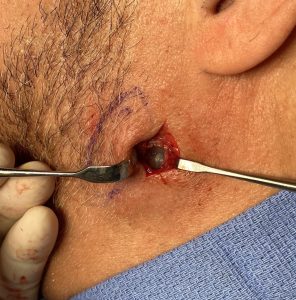The only effective method for jaw angle augmentation is with the use of implants. Placing an implant on or over the bony jaw angles is difficult to get it into the exact right position for the patient’s aesthetic needs and then to do in a perfectly symmetric fashion on both sides. Combined with what exact augmentation amount is best seen by the patient adds to the risk of the desire/need for postoperative implant adjustment.
All jaw angle implants, whether they are standard or part of a custom jawline implant, are placed through an intraoral approach. When it comes to a jaw angle revision, reusing the intraoral approach is not very appealing. There is always the ever present risk of infection as well as the associated recovery.

The key to using the direct transcutaneous is what can and can not be done through it. If the implant needs to be repositioned either higher or lower over the end of the jaw angle bone this is a very effective way to do it and allows for screw fixation right through the implant to the bone. If the width of the implant needs to be reduced a few millimeters over its end, a scalp can do this well. If an onlay implant needs to be added to increase width it can be placed through this small window of access. (provided it is a semi-flexible silicone implant)
Dr. Barry Eppley
Indianapolis, Indiana



